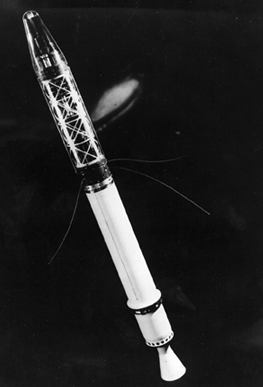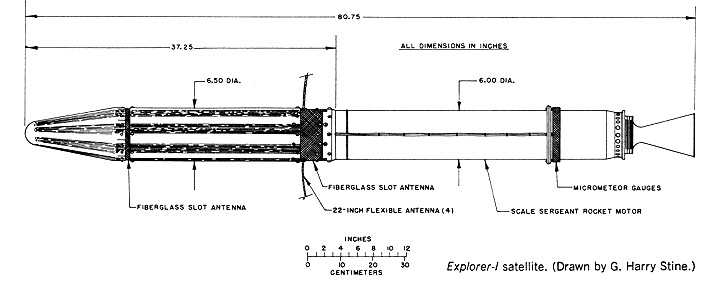Moment of Inertia
Today, government secrecy sabotages an early satellite. The University of Houston's College of Engineering presents this series about the machines that make our civilization run, and the people whose ingenuity created them.
In 1985 Peter Likins, then President of Lehigh University, told an intriguing tale about the first satellites that orbited Earth. The Russian Sputniks I and II flew in October and November 1957. The American Explorer I flew in January 1958.
The two Sputniks were not quite spherical. But Explorer I was long and narrow like a pencil. It was supposed to rotate around its own centerline, like a pencil spinning about its lead. It was definitely not supposed to rotate end over end like an airplane propeller or a windmill blade.
Technically speaking, we say a pencil spinning about its lead is in its minimum moment of inertia mode. The windmilling pencil is in its maximum moment of inertia mode, and it spins more slowly.
A radio astronomer named Ronald Bracewell, at Stanford University, tracked the first Sputnik and determined that it was spinning in its maximum moment of inertia mode. As its antennae flexed, it dissipated a small amount of rotational energy. That'd destabilized any rotation that was not in the maximum moment of inertia mode.
Bracewell knew about that behavior because that's how galaxies behave. What he knew, and Explorer's engineers didn't, was that Explorer I's rotation would be unstable. It would soon flip over and start windmilling through space. That's what a spinning coin does. It starts out spinning about one of its diameters. Then, as it spends its energy, the rotation flattens out. It tries to go horizontal and spin like a turntable.
So Bracewell called engineers at the Jet Propulsion Laboratory to warn them. But people in charge of security wouldn't let him talk with the engineers. He had to get the word out by publishing a paper in the open literature. It came out seven months after Explorer I was launched. Once up, Explorer I made just one earth orbit. Then it flipped over, and from then on it windmilled across the heavens.
Actually, in 1957 another engineer named Landon described that kind of instability in laboratory notes at RCA. But he didn't publish them, nor was he aware of the Explorer problem. Information that isn't public can't do anyone much good.
There can, I suppose, be good reasons for secrecy in technology. But make no mistake, secrecy is an enemy of progress. Creativity, freedom, and openness are natural bedfellows.
Ten years ago, a Russian engineer pointed out why we stayed ahead of Russia in computer development. Once we'd established a lead, he said, Russia tried to keep up by copying what we'd already done. They had plenty of ways to break through our security. But, being forced by their system to play that game, instead of being allowed to trust their own inventive genius, they were trapped in a technology that was doomed to stay one step behind us.
I'm John Lienhard, at the University of Houston, where we're interested in the way inventive minds work.
(Theme music)
Likens, P., Spacecraft Attitude Dynamics and Control -- A Personal Perspective on Early Developments. Invited Lecture preprint, American Institute of Aeronautics and Astronautics, 1985.
Bracewell, R. N., and Garriot, O. K., Rotation of Artificial Earth Satellites. Nature, Vol. 182, Sept. 20, 1958, pp. 760 et seq.
This is a revised version of Episode 47. I am grateful to James Casey, University of California at Berkeley, for suggesting this topic and for considerable counsel on the subject.
For another illustration of the stability phenomenon we describe here, see Episode 1313 and especially the discussion of the rattleback in the endnotes.
For more on Explorer I, click here.


Images of Explorer I, courtesy of NASA